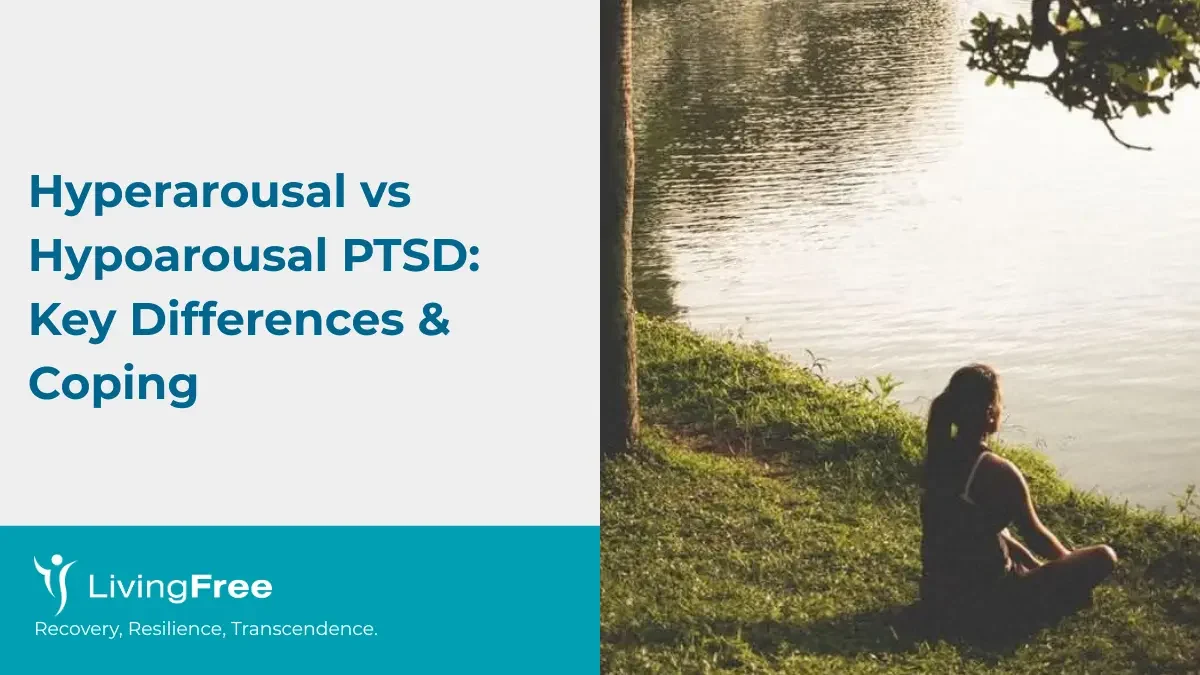People with PTSD or complex trauma often move between two extreme nervous-system states, hyperarousal vs hypoarousal PTSD. This is the difference: hyperarousal (over-activated) and hypoarousal (shut down). These states reflect how trauma affects the brain’s threat-response system.
Knowing the difference helps survivors identify symptoms early and develop better regulation strategies.
Hyperarousal: The “Fight or Flight” Overdrive
Hyperarousal happens when the sympathetic nervous system stays switched on, even when there’s no danger.
Common Symptoms
- Feeling constantly on edge: a persistent state of alertness, as if danger is around the corner.
- Hypervigilance: scanning the environment for threats, difficulty relaxing.
- Being easily startled: strong reactions to sudden noises or movements.
- Rapid heartbeat: increased pulse, tight chest, or shallow breathing.
- Difficulty concentrating: trouble focusing due to mental overload.
- Irritability or sudden anger: emotions feel intense and hard to control.
- Sleep disturbance: insomnia, nightmares, or restless sleep.
- Panic-like sensations: trembling, sweating, or overwhelming anxiety.
How Hyperasousal Impacts Daily Life
People in hyperarousal might appear jumpy, tense, or defensive. Small stressors can feel overwhelming, leading to emotional outbursts, overthinking, and exhaustion.
Hypoarousal: The “Freeze or Shutdown” Response
Hypoarousal occurs when the nervous system goes into a protective shutdown mode, often after overwhelming or inescapable danger.
Common Symptoms
- Emotional numbness: inability to feel joy, sadness, or connection.Low energy or fatigue — exhaustion that doesn’t match physical activity.
- Disconnection from reality: feeling foggy or “not fully present.”
- Dissociation: spacing out, losing time, or feeling detached from yourself.
- Slowed movement or speech: reduced motor activity and muted expression.
- Brain fog: difficulty thinking clearly or forming thoughts.
- Withdrawal: isolating from people or activities.
How Hypoarousal Impacts Daily Life
Hypoarousal makes tasks feel impossible. People may appear passive, uninterested, or “frozen,” even though internally they feel overwhelmed.
Why Trauma Causes These Opposite States
Trauma affects key parts of the brain that control threat responses:
1. The Amygdala
Becomes overactive, constantly detecting danger even when none exists.
2. The Prefrontal Cortex
Loses its ability to regulate emotions and apply logic during stress.
3. The Autonomic Nervous System
Swings between:
Sympathetic activation (fight/flight) → hyperarousal
Dorsal vagal shutdown (freeze) → hypoarousal
When trauma is severe or chronic, the person’s window of tolerance becomes very narrow. Here’s the table of differences:
| Aspect | Hyperarousal | Hypoarousal |
|---|---|---|
| Nervous system | Sympathetic | Parasympathetic (dorsal vagal) |
| Body state | Tense, alert | Slow, numb |
| Emotions | Fear, anxiety, anger | Emptiness, disconnection |
| Cognition | Racing thoughts | Foggy or blank |
| Behavior | Agitation or restlessness | Withdrawal or immobility |
| Purpose | Escape or defend | Survive the “inescapable” |
How These States Affect People With PTSD
People may:
- Experience mostly hyperarousal (common in early PTSD)
- Experience mostly hypoarousal (common in chronic trauma or dissociation)
- Switch between both, sometimes rapidly.
This fluctuation makes emotional regulation difficult and can impair work, relationships, and daily functioning.
How Clinicians Assess These States
Clinicians typically use:
- Diagnostic interviews (e.g., CAPS-5): evaluates trauma exposure and symptom clusters.
- PTSD symptom checklists: measures hyperarousal symptoms like insomnia or irritability.
- Dissociation scales: identifies hypoarousal patterns and dissociative episodes.
- Behavioral observation: noticing freeze responses, shutdowns, or physiological distress.
- Physiological data in research: heart rate, startle reflex, and skin conductance.
Evidence-Based Treatments
1. Trauma-Focused Psychotherapies
- Prolonged Exposure (PE): helps you safely face trauma memories to reduce fear responses.
- Cognitive Processing Therapy (CPT): targets unhelpful beliefs created by trauma.
- EMDR: uses bilateral stimulation to process traumatic memories more adaptively.
2. Somatic / Body-Oriented Therapies
- Somatic Experiencing — focuses on releasing stored survival energy.
- Sensorimotor Psychotherapy — integrates body awareness with talk therapy.
- Trauma-informed yoga — resets the nervous system through movement and breath.
- Polyvagal-informed therapy — builds capacity for safe social engagement.
3. Medications
- SSRIs/SNRIs — reduce overall PTSD symptoms and anxiety
- Prazosin (case-dependent) — helps with trauma-related nightmares and sleep disruption.
4. Skills for Regulation
- Grounding techniques — reconnect to the present moment through senses.
- Breathing exercises — calm the nervous system and reduce hyperarousal.
- Pacing strategies — prevent overwhelm by breaking tasks into manageable steps.
Coping Strategies You Can Practice
When your body shifts into hyperarousal or hypoarousal, small, intentional practices can help you return to a steadier place. These techniques are a good place to begin.
If You’re in Hyperarousal
- Slow diaphragmatic breathing: activates the calming parasympathetic system.
- Progressive muscle relaxation: relieves physical tension stored in the body.
- Temperature grounding (ice, cool water): interrupts panic signals.
- Gentle movement: walking or stretching helps release excess energy.
If You’re in Hypoarousal
- Cold water on the face: stimulates the vagus nerve to increase alertness.
- Upbeat music: provides sensory input that lifts low arousal.
- Brisk movement: shaking limbs or marching boosts circulation and awareness.
- 5-senses activation: naming things you see/hear/feel brings you back online.
If You Cycle Between Both
- Trigger tracking: notice what pushes you above or below your tolerance window.
- Pre-emptive regulation: practice calming or energizing skills before overwhelm hits.
- Structured routines: reduce unpredictability and support nervous-system stability.
When to Seek Professional Help
Reach out to a therapist or doctor if:
- Symptoms persist more than one month.
- Feel detached, unsafe, or emotionally overwhelmed.
- Experience intense dissociation or shutdowns.
- Work, school, or relationships are affected.
- Early treatment significantly improves recovery outcomes.
You’re not alone in this. If these symptoms feel familiar, know that nothing is “wrong” with you, and your body is responding to past overwhelm. With the right support, it can learn to feel safe again.
If you’re ready, reaching out to a trauma-informed professional or exploring gentle regulation tools can be a helpful next step. Or you can contact us here. Healing doesn’t have to be done alone.
Related Reading:


